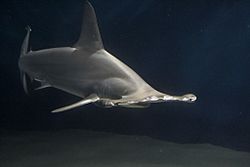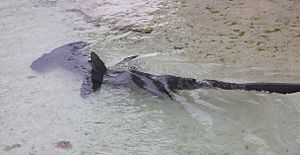Hammerhead shark facts for kids
Quick facts for kids Hammerhead sharkTemporal range: Middle Miocene to Present
|
|
|---|---|
 |
|
| A Hammerhead shark, Sphyrna lewini | |
| Scientific classification | |
| Kingdom: | |
| Phylum: | |
| Class: | |
| Subclass: | |
| Order: | |
| Family: |
Sphyrnidae
|
| Genera | |
 |
|
| Map of Hammerhead Sharks (In blue) | |
Hammerhead sharks are a special group of sharks. They get their name from their unique, flat, hammer-shaped heads. This "hammer" is also called a "cephalofoil." It helps them see almost everything around them, even what's above and below. This special head also gives them amazing depth perception, which means they can judge distances very well.
Hammerhead sharks belong to the animal family called Sphyrnidae.
You can find hammerheads all over the world, especially in warmer ocean waters. They like to live near coastlines and continental shelves. In the summer, many hammerheads travel together to find cooler places to swim.
Unlike most sharks, some hammerhead species swim in big groups during the day. But when night comes, they become solitary hunters, searching for food alone.
Contents
About Hammerhead Sharks

There are nine different species of hammerhead sharks known today. They can be quite different in size. Some are as short as 0.9 meters (about 3 feet), while others can grow up to 6.1 meters (about 20 feet) long!
Their weight also varies a lot, from about 225 kilograms (500 pounds) to 450 kilograms (1000 pounds). Hammerheads are usually light grey with a hint of green, and their bellies are white.
The hammer-like shape of their head helps them make very sharp turns in the water. It also helps them find prey by sensing tiny electrical signals. Hammerheads have smaller mouths compared to other types of sharks.
What Hammerheads Eat
Hammerhead sharks are strong hunters. They eat many different sea creatures. Their diet includes crustaceans like crabs, molluscs such as octopuses and squids, and various types of fish. They even eat other kinds of sharks!
Their favorite food is stingrays. Hammerhead sharks are known to swim close to the ocean floor, looking for their prey. They use their unique "cephalofoil" head as a tool. They hit stingrays with their heads to stun or weaken them, then they eat them.
If food is scarce, hammerhead sharks have been known to eat other hammerheads. Interestingly, Great hammerhead sharks have even been seen eating their own young.
Who Hunts Hammerheads?
Adult hammerhead sharks don't really have natural predators. They are at the top of their food chain! However, young hammerhead sharks can be hunted by other shark species, hungry killer whales, or even adult hammerheads.
Reproduction and Life Cycle
Hammerhead sharks are viviparous. This means they give birth to live young, just like humans do, instead of laying eggs. Female hammerheads usually have 12 to 15 babies, called pups, at a time. The Great hammerhead shark can have even more, giving birth to about 20 to 40 pups!
After they are born, baby hammerhead sharks often gather in groups. They swim together towards warmer waters, where they can grow safely. They stay in these groups until they are big and strong enough to live on their own. Hammerhead sharks typically live for about 20 to 30 years.
In 2007, scientists made an amazing discovery about the bonnethead shark, a type of hammerhead. They found it could reproduce without a male partner! This is called asexual reproduction, and the bonnethead was the first shark ever known to do this.
How Hammerheads Evolved

Sharks don't have bones that turn into fossils easily. So, we mostly find their teeth as fossils. Hammerhead sharks are closely related to requiem sharks.
Based on DNA studies and the fossils we have, scientists believe that the ancestors of hammerhead sharks lived about 20 million years ago. This was during the Early Miocene epoch. Genetic studies also suggest that hammerheads evolved from the Winghead shark.
Hammerhead Species
There are nine different species of hammerhead sharks found in the wild. Some examples include:
- The Winghead shark (Eusphyra blochii)
- The Scalloped hammerhead (Sphyrna lewini)
- The Great hammerhead (Sphyrna mokarran)
- The Bonnethead (Sphyrna tiburo)
- The Smooth hammerhead (Sphyrna zygaena)
Hammerheads and Humans
Hammerhead sharks are generally not a big threat to humans. Since 1580, there have only been 17 recorded unprovoked attacks by hammerheads on humans. No human deaths have ever been recorded from these attacks. Most hammerhead species are too small to cause serious harm to people.
Sadly, many hammerhead species are now in danger. The great and scalloped hammerheads are listed as endangered by the IUCN. The smalleye hammerhead is listed as vulnerable. This is mainly because of overfishing and the high demand for their fins.
Shark fins are considered a special food in some Asian countries, like China. Fishermen often catch sharks, cut off their fins, and then throw the rest of the shark, often still alive, back into the ocean. This cruel practice is called finning, and it kills the shark. Scientists are very worried about the future of these sharks.
Hammerheads in Aquariums
It's quite difficult to keep large hammerhead sharks in aquariums. The smaller bonnethead shark is more commonly seen in public aquariums because it's easier to care for. However, even bonnetheads need very specific conditions.
Larger hammerhead species need huge, specially designed tanks. They can get stressed during transport and might hurt themselves by rubbing against tank surfaces or hitting rocks. Because of these challenges, only a few public aquariums around the world have been able to keep large hammerheads for a long time. The scalloped hammerhead is the most common large species kept, mainly in North America, Europe, and Asia.
Protecting Hammerhead Sharks
Humans are the biggest threat to hammerhead sharks. Even though fishermen don't always target them directly, hammerheads are often caught by accident in fishing nets around the world. Since they prefer warm waters, many are caught in tropical fisheries.
The number of hammerheads caught has increased a lot. In 1990, about 75 metric tons were caught, but by 2010, this number jumped to 6,313 metric tons.
Shark fin traders value hammerhead fins highly. Hong Kong is the world's largest market for shark fins. It's estimated that about 375,000 great hammerhead sharks are traded each year, mostly for their fins. The rest of the shark's body is often thrown away because the meat is not as popular.
In 2013, three endangered shark species, including hammerheads, were added to a special list by CITES. This means that fishing and trading these sharks are now regulated and require special licenses. This is an important step to help protect them.
Cultural Importance
For the Torres Strait Islanders, the hammerhead shark, called beizam, is a common family totem. It often appears in their cultural items, like the fancy headdresses called dhari (dari) worn for ceremonial dances. The beizam is linked to law and order in their culture.
In native Hawaiian culture, sharks are seen as gods of the sea. They are believed to protect humans and keep the ocean healthy. Some Hawaiians believe that certain sharks are family members who have come back as sharks. However, some sharks, called niuhi, are considered man-eaters. These include great white sharks, tiger sharks, and bull sharks.
The hammerhead shark, known as mano kihikihi, is not a niuhi. It is one of the most respected sharks in the ocean, called an aumakua. Many Hawaiian families believe they have an aumakua watching over them and protecting them from the niuhi. Some Hawaiian children are even believed to have the hammerhead shark as their birth animal. These children are thought to be warriors meant to explore the oceans. When hammerhead sharks swim near the waters of Maui, many natives see it as a sign that the gods are watching over their families and that the oceans are healthy.
Images for kids
See also
 In Spanish: Tiburón martillo para niños
In Spanish: Tiburón martillo para niños






